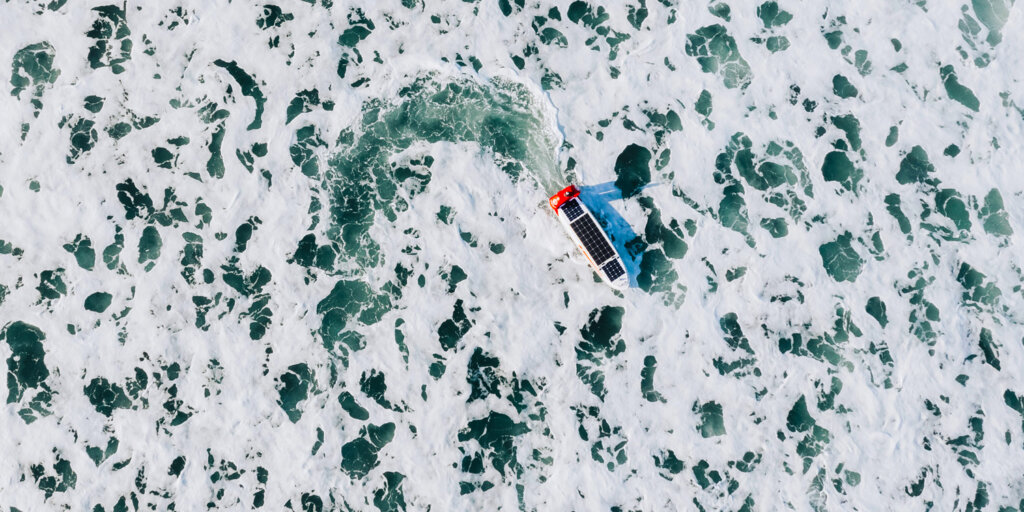Home » Open Ocean Robotics is shedding light on the murky depths
Open Ocean Robotics is shedding light on the murky depths

Julie Angus interprets the phrase “a sea of information” more literally than most. As a former expeditioner (she was the first woman to row across the Atlantic), as well as CEO and cofounder of robot boat company Open Ocean Robotics, she views data collection as the key to protecting our oceans. “Close to 80 percent of our oceans are unobserved, unexplored, unmapped,” she says. “And that leads to all kinds of challenges.”
To increase our knowledge about the ocean, her company builds and deploys autonomous boats that collect data on everything from temperatures to sea levels. Oceans bear the brunt of climate change, absorbing 25 percent of carbon dioxide emissions and 90 percent of the excess heat those emissions generate, according to a United Nations report. “Collecting data and understanding our oceans is core to protecting our oceans,” Angus says.

What it can measure
Open Ocean’s drone boats are kitted out with various sensors, depending on the needs of the mission. All boats come standard with 360-degree cameras and weather monitoring devices, as well as sensors to measure water depth, waves height and temperature. They can also keep tabs on chlorophyll and oxygen levels, as well as identify marine mammals. By using Automatic Identification Systems (AIS), the boats can detect other vessels and analyze shipping patterns, and hydrophone arrays help researchers listen underwater. Other gadgets — thermal cameras, radar, seafloor mapping devices and sonar — help map and monitor areas.

Its capabilities
Compared to big research vessels, Open Ocean’s boats are tiny: at 3.5-metres long and less than a metre wide, they’re only a little bigger than a kayak. Yet you’d be surprised by how well they can handle a 50-foot wave. The boats are built to adhere to an important design principle that Angus relied on in her Atlantic rowing days: the ability to self-right. The company has patented its rollbar to help the boats sail in all weather.
Open Ocean’s solar-powered boats can operate continuously for up to six months, and Angus and her team do modelling to ensure they have enough power for the duration of their expeditions. Using its proprietary software portal, the team can access and analyze information in real-time or near real-time, as well as alter the route of the boat on the fly, making the company’s boats as dynamic as their manned counterparts.

How it helps
Manned research vessels are big greenhouse gas emitters — so much so that taking one of these vessels off the water for a week would be the equivalent of taking 100 cars off the road for a year. “Our boats are able to do many of the things a normal crewed ship could do but at a much lower cost and without any of the greenhouse gas emissions,” she says. Open Ocean’s boats can patrol the ocean to help monitor for illegal fishing, which currently accounts for 20 percent of all wild fish caught. The boats have monitored illegal fishing in a humpback whale reserve near Hawaii and mapped coastal areas off of B.C. They can also measure noise levels of off-shore wind farms and shipping boats, as well as listen to marine animals. These patrol and research features, along with the ability to map shorelines (including hard-to-traverse Arctic regions, which are ever-changing due to climate change), offer a glimpse of what ocean management could soon look like.
Creating a connected ocean
The future of ocean management is digital, says Angus. The real-time data from her boats, combined in a network with other drones, underwater vehicles and satellites, could provide the information needed to create more fuel-efficient shipping routes, more policing against illegal fishing and more actionable insights toward marine life protection — all at a scale that would be unprecedented, and only possible with a network approach to ocean data. “It will be uncrewed surface vehicles like us, as well as underwater vehicles, aerial drones, satellites. We will eventually create a digital ocean where we can understand the ocean to a much better extent,” says Angus. “And that will help solve many of the challenges that we see currently on the ocean.”
MaRS believes “innovation” means advancing Canadian technology for the benefit of all people. Join our mission.
Photos courtesy of Open Ocean Robotics
MaRS Discovery District
https://www.marsdd.com/
MaRS is the world's largest urban innovation hub in Toronto that supports startups in the health, cleantech, fintech, and enterprise sectors. When MaRS opened in 2005 this concept of urban innovation was an untested theory. Today, it’s reshaping cities around the world. MaRS has been at the forefront of a wave of change that extends from Melbourne to Amsterdam and runs through San Francisco, London, Medellín, Los Angeles, Paris and New York. These global cities are now striving to create what we have in Toronto: a dense innovation district that co-locates universities, startups, corporates and investors. In this increasingly competitive landscape, scale matters more than ever – the best talent is attracted to the brightest innovation hotspots.


